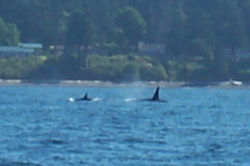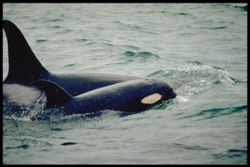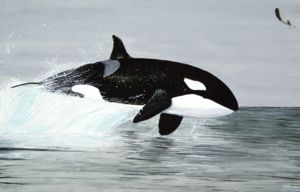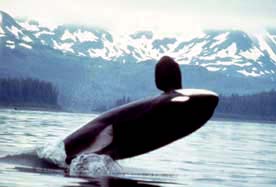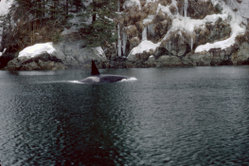Orca
2007 Schools Wikipedia Selection. Related subjects: Mammals
| iOrca |
||||||||||||||||
|---|---|---|---|---|---|---|---|---|---|---|---|---|---|---|---|---|
 A male orca with its characteristic tall dorsal fin swims in the waters near Tysfjord, Norway 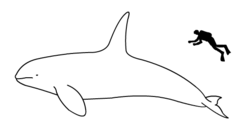 Size comparison against an average human
|
||||||||||||||||
|
|
||||||||||||||||
| Scientific classification | ||||||||||||||||
|
||||||||||||||||
|
|
||||||||||||||||
| Orcinus orca Linnaeus, 1758 |
||||||||||||||||
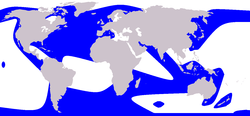 Orca range (in blue)
|
The Orca or Killer Whale (Orcinus orca) is the largest species of the oceanic dolphin family ( Delphinidae). They are sometimes referred to as blackfish, a group including pilot whales, pygmy and false killer whales, and melon-headed whales. It is the second-most widely distributed mammal on Earth (after humans) and is found in all the world's oceans, from the frigid Arctic regions to warm, tropical seas. It is also a versatile predator, eating fish, sea turtles, seabirds, pinnipeds, elasmobranchs, sirenians and even other cetaceans. This puts the orca at the pinnacle of the marine food chain.
Orcas are marine mammals with a fearsome reputation that goes as far back as Pliny the Elder's description of the species. The name "killer whale" reflects the animal's habit of attacking whales, and does not mean that orcas are a threat to humans. Aside from a boy who was charged (but not grabbed) while swimming in a bay in Alaska, there have been no confirmed attacks on humans in the wild. There have, however, been isolated reports of captive orcas attacking their handlers at marine theme parks.
Nomenclature
The name "orca" (plural "orcas") was originally given to these animals by the ancient Romans, possibly borrowed from the Greek word ὄρυξ which (among other things) referred to a species of whale. The term "orc" (or its variant "ork") has been used to describe a large fish, whale or sea-monster. It is now considered an obsolete equivalent for "orca."
The name "killer whale" is widely used in common English. However, since the 1960s, "orca" has steadily grown in popularity as the common name to identify the species, and both names are now used. The species is called orca in most other European languages, and, as there has been a steady increase in the amount of international research on the species, there has been a convergence in naming.
A pod of orcas is capable of killing a large whale. It is commonly thought that 18th-century Spanish sailors dubbed these creatures asesina-ballenas, or "whale killer" for this reason. However, this title was improperly translated into English as "killer whale". The term became so prevalent that Spanish speakers commonly used its retranslation of ballena asesina.
There are still many, especially in the research community, who prefer the original name, believing it to be an appropriate description of a species that does indeed kill many animals, including other cetaceans. These supporters of the original name point out that the naming heritage is not limited to Spanish sailors. Indeed the genus name "Orcinus" means "from Hell" (see Orcus), and although the name "orca" (in use since antiquity) is probably not etymologically related, the assonance might have given some people the idea that it means "whale that brings death," or "demon from hell."
The name of this species is similarly intimidating in many other languages. In Finnish and in Dutch it is called miekkavalas and zwaardwalvis respectively, which means "sword whale". To the Haida people native to the islands of Haida Gwaii off the coast of British Columbia, the animal was known as skana or "killing demon". The Japanese call them shachi (鯱), whose kanji character combines the radicals for fish (魚) and tiger (虎).
A former name for the species is grampus. This is now seldom used and should not be confused with the Grampus genus (containing Risso's Dolphin).
Taxonomy and evolution
The orca is the sole species in the genus Orcinus. It is one of thirty-five species in the dolphin family. Like the Sperm Whale genus Physeter, Orcinus is a genus with a single, abundant species with no immediate relatives from a cladistic point of view, thus paleontologists believe that the orca is a prime candidate to have an anagenetic evolutionary history — that is the evolution of ancestral to descendant species without splitting of the lineage. If true, this would make the orca one of the oldest dolphin species, although it is unlikely to be as old as the family itself, which is known to date back at least five million years.
However, there are are at least three types of orcas that are genetically distinct enough to be considered different subspecies or races. These classifications are based mostly on research performed off the west coast of Canada and the United States.
The three types are:
- Resident: These are the most commonly sighted of the three populations in the coastal waters of the northeast Pacific. The resident orcas' diet consists primarily of fish, and they live in complex and cohesive family groups known as pods. Female residents characteristically have a rounded dorsal fin tip that terminates in a sharp corner. They are known to visit certain areas consistently.
- Transient: The diet of these orcas consists almost exclusively of marine mammals. They do not eat fish. Transients generally travel in small groups, usually of two to six animals. Unlike residents, transients may not always stay together as a family unit. Female transients are characterized by dorsal fins that are more triangular and pointed than those of residents.
- Offshore: These orcas cruise the open oceans and feeding primarily on fish, sharks and turtles. They have been seen traveling in groups of up to 60 animals. Currently there is little known about the habits of this population, but they can be distinguished genetically from the residents and transients. Female offshores are characterized by dorsal fin tips that are continuously rounded.
Transient and resident orcas live in the same areas but generally ignore each other. The name "transient" originated from the belief that these whales, which are often seen in groups of three or four, were outcasts from larger resident pods. Researchers later discovered that transients are an entirely different community. Recent genetic research has found that the types have not interbred for up to 10,000 years (Chadwick).
An additional two or three orca types have recently been documented in the Antarctic. Type A looks like a typical orca, living in open water and feeding mostly on minke whales. Type B and type C whales are smaller than type A. Both B and C types have grayish and light yellow skin in place of the usual black and white orca colouring; B and C types can also be distinguished from each other through variations in colour pattern. They live close to the Antarctic ice pack, with type B whales feeding mostly on seals, and type C on fish.
Physical characteristics
Orcas are distinctively marked, with a black back, white chest and sides, and a white patch above and behind the eye. They have a heavy and stocky body and a large dorsal fin with a dark gray "saddle patch" at the fin's rear. Males can be up to 9.5 m long (31 ft) and weigh in excess of 6 tons; it has been reported that especially large males have reached nearer 8 tons. Females are smaller, reaching up to 8.5 m (28 ft) and a weight of about 5 tons. The longest orca ever recorded was a male from Washington state, measuring 9.8 m (32 ft). Calves at birth weigh about 180 kg and are about 2.4 m long (8 ft). The orca's large size and strength make them one of the fastest marine mammals, often reaching speeds in excess of 35mph.
Unlike most dolphins, the pectoral fin of an orca is large and rounded — more of a paddle than other dolphin species. Males have significantly larger pectoral fins than females. At about 1.8 m (6 ft), the dorsal fin of the male is more than twice the size of the female's, and is more of a triangle shape — a tall, elongated isosceles triangle, whereas the dorsal fin of the female is shorter and generally more curved. Nicks, cuts and scrapes on these fins, as well as distinctive features of each fin, help scientists identify individuals.
Large male orcas are very distinctive and are unlikely to be confused with any other sea creature. When seen from a distance in temperate waters, females and juveniles can be confused with various other species, such as the false killer whale or Risso's dolphin.
Most life history data about orcas has been obtained from long-term surveys of the population off the coasts of British Columbia and Washington and by monitoring captive orcas. Due to the completeness of the study and highly structured nature of the pods in this population, the information is detailed and accurate; however, transient groups and groups in other oceans may have slightly different characteristics. Females become sexually mature at around 15 years of age. From then they have periods of polyestrous cycling with non-cycling periods of between three and sixteen months. The gestation period varies from fifteen to eighteen months. Mothers calve, with a single offspring, about once every five years. In analysed resident pods, birth occurs at any time of year, with the most popular months being those in winter. Newborn mortality is very high — one survey suggested that nearly half of all calves fail to reach the age of six months. Calves nurse for up to two years, but will start to take solid food at about twelve months. Cows breed until the age of 40, meaning that on average they raise five offspring. Typically, females live to the age of fifty, but may survive well into their eighties or nineties in exceptional cases. Males become sexually mature at the age of 15, but do not typically reproduce until age 21. Males live to about 45 on average, and close to 90 in exceptional cases.
Range
The orca is the second-most widely distributed mammal in the world, after the human. They are found in all oceans and most seas, including (unusual for cetaceans) the Mediterranean and Arabian seas. Cooler temperate and polar regions are preferred, however. Although sometimes spotted in deep water, coastal areas are generally preferred to pelagic environments.
The orca is particularly highly concentrated in the northeast Pacific Basin, where Canada curves into Alaska, off the coast of Iceland and off the coast of northern Norway. They are regularly sighted in Antarctic waters right up to the ice-pack and are believed to venture under the pack and survive breathing in air pockets like the beluga does. In the Arctic, however, the species is rarely seen in winter, as it does not approach the ice pack. It does visit these waters during summer.
Information for off-shore regions and tropical waters is more scarce but widespread, if not frequent; sightings indicate that the orca can survive in most water temperatures. Sightings are rare in Indonesian and Philippine waters. No estimate for the total worldwide population exists. Local estimates include 70-80,000 in the Antarctic, 8,000 in the tropical Pacific (although tropical waters are not the orca's preferred environment, the sheer size of this area — 19 million square kilometres — means there are thousands of orcas), up to 2,000 off Japan, 1,500 off the cooler northeast Pacific and 1,500 off Norway. Adding very rough estimates for unsurveyed areas, the total population could be around 100,000.
Diet
The orca is an apex predator, and the array of species on which orcas prey is extremely diverse. Specific populations show a high degree of specialization on particular prey species. For example, some populations in the Norwegian and Greenland sea specialise in herring and follow that fish's migratory path to the Norwegian coast each autumn. Other populations in the area prey on seals. On average, an orca eats 500 lbs. (227 kg) of food each day.
Fish and other cold-blooded prey
Fish-eating populations of orcas prey on 30 species of fish, particularly salmon (including Chinook and Coho), herring, and tuna. Basking sharks, oceanic whitetip sharks, and occasionally even great white sharks are taken for their nutrient-rich livers. Cephalopods, such as octopuses and a wide range of squids, are also targets.
While salmon are usually hunted by a single orca or a small group of individuals, herring are often caught using carousel feeding: the orcas force the herring into a tight ball by releasing bursts of bubbles or flashing their white undersides. The orcas then slap the ball with their tail flukes, either stunning or killing up to 10-15 herring with a successful slap. The herring are then eaten one at a time. Carousel feeding has only been documented in the Norwegian orca population and with some oceanic dolphin species.
Warm-blooded prey
The orca is the only cetacean species to regularly prey on other cetaceans. Twenty-two species have been recorded as preyed on, either through an examination of stomach contents, examining scarring on the prey's body, or from observing the orcas' feeding activity. Groups of orcas will even prey on larger cetaceans such as minke whales, gray whales, female and juvenile sperm whales or young blue whales. A group of orcas take a young whale by chasing it and its mother through the sea, wearing them out. Eventually the orcas manage to separate the pair and surround the young whale, preventing it from returning to the sea's surface to breathe. Large whales are typically drowned in this manner. Pods of female sperm whales can sometimes protect themselves against a group of orcas by forming a protective circle around their calves with their flukes facing outwards. This formation allows them to use their powerful flukes to repel the orcas.
Other marine mammals, including most species of seal and sea lion, are preyed upon by Orcas. Walrus and sea otters are hunted less frequently. Several species of bird are also preyed upon, including penguins, cormorants and sea gulls. Sea lions are killed by head-butting or by being slapped and stunned by a tail fluke.
A captive orca in Friendship Cove discovered that it could regurgitate fish onto the surface, attract sea gulls, and eat them. Other orcas then learned the behaviour by example. Orcas at Sea World California have also been observed hunting birds.
There has also been one recorded case of probable orca cannibalism. A study carried out by V. I. Shevchenko in the temperate areas of the South Pacific in 1975 recorded two male orcas whose stomachs contained the remains of other orcas. Of the 30 orcas captured and examined in this survey, 11 had empty stomachs — an unusually high percentage which indicates the orcas were forced to cannibalism through a lack of food.
Orcas use complex hunting strategies to find and subdue their prey. They will occasionally throw seals through the air in order to stun and kill them. Often, to avoid injury, they will disable their prey before killing and eating it. This may involve throwing it in the air, slapping it with their tails, ramming it, or breaching and landing on it.
More specialized feeding techniques are used by various populations around the world. In Patagonia, and the Iles Crozet in the Indian Ocean, orcas feed on South American sea lion and elephant seal pups in shallow water; even to the extent of purposely stranding themselves (temporarily). Orcas will spy-hop to locate seals resting on ice floes, and then create a wave to wash over the floe, causing the seal to be thrown into the water where a second orca waits to kill it. This behaviour has only been recorded a few times and it is not known how often it occurs. The most recent recorded instance in April 2006 ended with the group of orcas returning the seal to the ice floe once they had shown the younger animals how to properly perform the technique.
Behaviour
The day-to-day behaviour of orcas is generally divided into four activities: foraging, travelling, resting and socializing. Orcas are generally enthusiastic in their socializing, engaging in behaviours such as breaching, spyhopping, and tail-slapping. All-male groups often interact with erect penises. Whether this interaction is part of play or a display of dominance is not known.
Resident orcas can also be seen swimming with porpoises, other dolphins and sea lions, which are common prey for transient orcas. Resident orcas are continually on the move, sometimes traveling as much as 100 miles (160 km) in a day, but may be seen in a general area for a month or more. Range for resident orca pods may be as much as 800 miles (1300 km) or as little as 200 miles (320 km). Unlike residents, transients often travel and hunt in silence.
Social structure of resident orca communities
Fish-eating orcas in the North Pacific have a complex system of social grouping. Unlike any other mammal population whose social structure is known, resident orcas of both sexes live with their mothers for their entire lives. The basic unit is the matriline, which consists of a single female (the matriarch) and her descendants. The sons and daughters of the matriarch form part of the line, as do the sons and daughters of those daughters (the sons and daughters of the sons join the matriline of their mates) and so on down the family tree.
Because females can live for up to ninety years, it is not uncommon for four or even five generations to travel together. These matrilineal groups are highly stable over many years. Individuals will only split off from their matrilineal group for up to a few hours at a time in order to mate or forage. No permanent casting out of an individual from a matriline has ever been recorded. The average matriline size as recorded in northeast Pacific waters is nine animals.
Matrilines form loose aggregations called pods, consisting on average of about 18 animals. Members of a pod all have the same dialect (see the section on vocal behaviour below) and consist of closely related matriline fragments. Unlike matrilines, pods will split apart for days or weeks at a time in order to carry out foraging before joining back together. The largest recorded pod is 49 animals. Orcas within a pod do not interbreed; mating occurs only between members of different pods.
Resident pods are generally larger than the transient and offshore pods, having up to 50 or more members. Several pods occasionally join to form what are referred to as superpods, sometimes numbering in excess of 150 animals.
The next level of grouping is the clan. A clan consists of those pods which have a similar dialect. Again the relationship between pods appears to be genealogical, consisting of fragments of families with a common heritage on the maternal side. Different clans can occupy the same geographical area; pods from different clans are often recorded traveling together. When resident pods come together to travel as a clan, they greet each other by forming two parallel lines akin to a face-off before mingling with each other.
The final layer of association, perhaps more arbitrary and devised by humans rather than the other very natural divisions, is called the community and is loosely defined as the set of clans that are regularly seen mixing with each other. Communities do not follow discernible familial or vocal patterns.
In the northeast Pacific, three communities of fish-eating orcas have been identified:
-
- The southern community (1 clan, 3 pods, 90 orcas as of 2006)
- The northern community (3 clans, 16 pods, 214 orcas as of 2000)
- The south Alaskan community (2 clans, 11 pods, 211 orcas as of 2000)
It should be emphasized that these hierarchies are valid for resident groups only. Transient groups are generally smaller because, although they too are based on matrilines, some male and female offspring eventually disperse from the maternal group. However, transient groups still have a loose connection defined by their dialect.
Vocal behaviour
As with other dolphins, orcas are very vocal animals. They produce a variety of clicks and whistles that are used for communication and echolocation. The vocalization types vary with activity. While resting they are much quieter, merely emitting an occasional call that is distinct from those heard when engaging in more active behaviour.
Fish-eating resident groups of orcas in the Northeast Pacific tend to be much more vocal than transient groups living in the same waters. Resident orcas feed on fish, particularly Pacific salmon, a prey with poor underwater hearing that cannot detect orca calls at any significant distance. Transient orcas on the other hand feed mainly on marine mammals and occasionally on seabirds. Because all marine mammals have excellent underwater hearing, transients probably remain silent for much of the time to avoid detection by their acoustically-sensitive prey. They sometimes use a single click (called a cryptic click) rather than the long train of clicks observed in other populations.
Resident pods have group-specific dialects. Each pod has its own vocal repertoire or set of particular stereotyped underwater calls (call types). Every member of the pod seems to know all the call types of the pod, so it is not possible to identify a single animal using voice alone. A particular call type might be used by only one group or shared among several.
The number of call types shared by two groups appears to be a function of their genealogical relatedness rather than their geographical distance. Two groups that share a common set of ancestors but have grown apart in distance are likely to have a similar set of call types, indicating that calls are a learned behaviour.
Orcas and humans
Although only scientifically identified as a species in 1758, the orca has been known to humans since prehistoric times. The desert culture of the Nazca created a Nazca line presumably representing an orca (although it could be any whale) sometime between 200 BC and AD 600.
The first description of an orca is given in Pliny the Elder's Natural History (written circa 70 AD). The aura of invincibility around the all-consuming orca was well-established by this time. Having observed the public slaughter of a whale stranded at a harbour near Rome, Pliny writes, "Orcas, (the appearance of which no image can express, other than an enormous mass of savage flesh with teeth), are the enemy of [other whales]... they charge and pierce them like warships ramming."
Hunting
Orcas were targeted in commercial whaling for the middle part of the twentieth century once stocks of larger species had been depleted. Commercial hunting of orcas came to an abrupt halt in 1981 with the introduction of a moratorium on all whaling. (Although from a taxonomic point of view an orca is a dolphin rather than a whale, it is sufficiently large to come under the purview of the International Whaling Commission.)
The greatest hunter of orcas was Norway, which took an average of 56 animals per year from 1938 to 1981. Japan took an average of 43 animals from 1946 to 1981. (War year figures are not available but are likely to be fewer). The Soviet Union took a few animals each year in the Antarctic, with the extraordinary exception of the 1980 season when it took 916.
Today, no country carries out a substantial hunt. Japan usually takes a few individuals each year as part of its controversial program of scientific research as specified in IWC constitution. A similarly small level of subsistence whaling is carried out by Indonesia and Greenland. As well as being hunted for their meat, orcas have also been killed because of competition with fishermen. In the 1950s the United States Air Force, at the request of the Government of Iceland, used bombers and riflemen to slaughter orcas in Icelandic waters because they competed with humans for fish. The operation was considered a great success at the time by fishermen and the Icelandic government. However, many were unconvinced that orcas were responsible for the drop in fish stocks, blaming overfishing by humans instead. This debate has led to repeated studies of North Atlantic fish stocks, with neither side in the whaling debate giving ground since that time.
Orcas are also occasionally killed out of fear of their reputation. No human has ever been attacked by an orca in the wild, but sailors in Alaska shoot the animal occasionally out of concern for their own lives. This fear has generally dissipated in recent years due to better education about the species, including the appearance of orcas in aquariums and other aquatic attractions.
Co-operating with humans
More unusually, orcas have also been known to co-operate with humans in the hunting of whales. One famous incidence of this was near the port of Eden in South-Eastern Australia in the 1920s. A pod of orcas, led by a dominant male called Old Tom, would assist whalers in hunting baleen whales. The orcas would find the target whales, shepherd them into Twofold Bay and then alert the whalers to their presence and often help to kill the whales. In return the whalers allowed the orcas to eat the tongue and lips of the whale before hauling it ashore.
Captivity
The orca's intelligence, trainability, striking appearance, playfulness in captivity and sheer size have made it a popular exhibit at aquariums and various aquatic theme parks. The first orca capture and display occurred in Vancouver in 1964. Over the next 15 years around 60 or 70 orcas were taken from Pacific waters for this purpose. In the late 1970s and the first half of the 1980s, orcas were generally taken from Icelandic waters (50 in the five years to 1985). Since that time, orcas have been successfully bred in captivity and wild specimens are considerably rarer. Orcas in captivity may develop pathologies such as dorsal fin collapse, seen in 60-90% of captive males.
Several theories exists as to why the dorsal fin collapse occurs, namely that the cartilage that holds the fin erect is not yet strong enough to support the fin when the orca is placed in captivity. The hardening of the cartilage occurs in late adolescence, in which the orca spends much time in deep ocean waters, and it is theorized that the pressure the water exerts on the fin allows it to remain supported while the cartilage hardens. In captivity, however, the tank the whales reside in lack sufficient water pressure to produce this effect, and the fin collapses before the cartilage that would support it in nature solidifies. Another theory exists that states that the whale is almost always in a state of turning in a tank, since it is not large enough to allow swimming in one direction for any normal duration. The constant turning exerts pressure on the dorsal fin, which in turn causes it to collapse.
There have been incidents with orcas in captivity attacking humans. In 1991, a group of 3 orcas (Haida, Nootka, and Tillikum) killed a trainer named Keltie Byrne at Sealand in Victoria, British Columbia (where employees were not allowed in the water with orcas), the orcas apparently not knowing Byrne could not survive underwater. After this, and due to Tilikum being bullied by the two females in the tank, Tilly (as he is nicknamed) was relocated to SeaWorld of Orlando, Florida, where he remains. He is currently the largest orca in captivity.
In 1999, at the SeaWorld park in Orlando, Florida,Tilikum killed a man who snuck into his tank after hours. . The man was found naked and draped over the orca's back the next morning. In late July 2004, during a show at the SeaWorld park in San Antonio, Texas, an orca pushed its trainer of ten years underwater and barred the way to the rim of the pool; the trainer could only be rescued from the animal after several minutes.
One of the more infamous incidents involving orca aggression took place in August 1989, when a dominant female orca, Kandu V, struck a newcomer orca, Corky II, with her mouth during a live show. Corky II had been imported from Marineland California just months prior to the incident. According to reports, a loud smack was heard across the stadium. Although trainers tried to keep the show rolling, the blow severed an artery near Kandu V's jaw, and she began spouting blood. The crowd was quickly ushered out, and after a 45-minute hemorrhage, Kandu V died. Opponents of these shows see these incidents as supporting their criticism.
SeaWorld continued to be under criticism from the Born Free Foundation over its continued captivity of the orca Corky II, who they want returned to her family, the A5 Pod, a large pod of orcas in British Columbia, Canada .
Orcas in captivity have vastly reduced life expectancies, on average only living into their 20s. In the wild, females may live into their 80s. The captive environment also bears no resemblance to their wild habitat, and the social groups that the orcas are put into are completely foreign to those found in the wild . Critics claim that captive life is stressful due to small tanks, false social groupings and chemically-altered water. Organisations such as the WSPA and the Whale and Dolphin Conservation Society campaign against the captivity of orcas.
The captive orca Namu developed a bacterial infection which damaged his nervous system, causing him to become non-responsive to people. During his illness he charged full speed into the wire mesh of his pen, thrashed violently for a few minutes and then died. A semi-documentary was named after him.
Environmental threats
The Exxon Valdez oil spill had an adverse effect on orcas in Prince William Sound and the Kenai Fjords region of Alaska. One resident pod was caught in the spill; though the pod successfully swam to clear water, eleven members of the pod (about half) disappeared in the following year. The spill had a long-term effect in reducing the amount of available prey, such as salmon, and has thus been responsible for a local population decline. In December 2004, scientists at the North Gulf Oceanic Society said that the AT1 transient population of orcas, now only numbering 7 individuals, has failed to reproduce at all since the spill. This population is expected to become extinct. Sightings Newsletter report on AT1 pod.
Like other animals at the highest trophic levels of the food chain, the orca is particularly susceptible to poisoning via accumulation of Polychlorinated biphenyls (PCBs) in the body. A survey of animals off the Washington coast found that PCB levels in orcas were higher than those in harbour seals in Europe that have been sickened by the chemical. Samples from the blubber of orcas in the Norwegian Arctic show higher levels of PCBs, pesticides and brominated flame-retardants than in Polar bears. However, no direct evidence of sickness in orcas has been found. The most likely effect, if any, would be a reduced rate of reproduction or decreased ability to fight off disease (immunodepression). In 2005, the United States government listed the Southern Resident population of orcas as an endangered species under the Endangered Species Act (ESA) due to deterioration of the three pods which spend most of the year in the Georgia and Haro Straits and Puget Sound in British Columbia and Washington state.
Heavy ship noise can interfere with the acoustic communication and echolocation of orcas. In the mid-1990s, loud underwater noises from salmon farms were used to deter seals. Orcas subsequently avoided the surrounding waters.
Orcas are popular object of whale watching, which may change orca behaviour and stress orcas, particularly if boats approach orcas too closely or block their line of travel.


